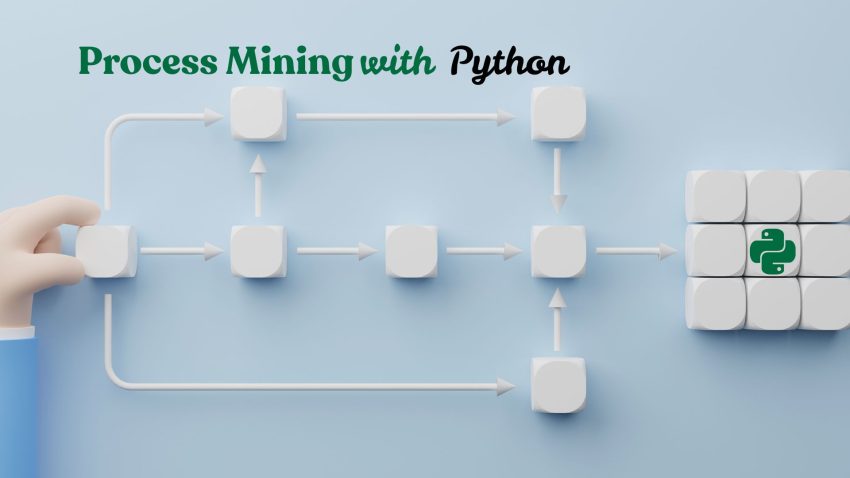Last year, I was sitting in yet another vendor demo for a process mining platform. The price tag? 6-figure$ for the first year, plus implementation costs. The sales rep was enthusiastic about their revolutionary(!) capabilities, but I couldn’t help thinking: “I could build something more tailored for a fraction of this cost.“
That’s when it hit me – we’ve been approaching process mining all wrong in supply chain.
The Enterprise Software Trap

Here’s the uncomfortable truth: most supply chain leaders are paying premium prices for process mining tools that barely scratch the surface of what’s possible. These enterprise platforms promise plug-and-play solutions, but reality is messier. You’re still spending months configuring dashboards, training users, and trying to make the software fit your unique processes.
Meanwhile, your data scientists or IT teams are struggling because the no-code interface can’t handle the complex supply chain scenarios you actually need to analyze.
Does it sound familiar?
Why Python Changes Everything for Supply Chain
Process mining isn’t a rocket science. It’s a pattern recognition in the event data. And guess what? Python excels at exactly this kind of analysis. Here’s why smart supply chain teams are prefering the Python instead of an expensive software.
Real-time adaptability: Your supplier payment process changed overnight due to new regulations? With Python, you adapt your analysis in hours, not months.
Custom metrics that matter: Track supplier lead time variability, stockout cascades, or demand sensing accuracy. These kind of metrics that generic tools can’t even conceptualize.
Integration freedom: Pull data from your ERP, WMS, TMS, and that Excel file your procurement team insists on using. Python doesn’t care about data silos.
Cost efficiency: One data scientist using Python can deliver more value than a team struggling with licensed software limitations.
A Real Supply Chain Example
Let me show you how this works in practice. Imagine you’re analyzing your order to delivery process across multiple distribution centers. Traditional process mining tools will show you the happy path, but they’ll miss the nuanced patterns that actually drive performance in supply chain.
With Python, you can:
- Identify seasonal bottlenecks by overlaying demand patterns with process flows
- Spot supplier behavior changes before they impact your operations
- Quantify the cost of process deviations in real business terms
- Predict where your next supply chain crisis will emerge
Here’s a simplified example of what this looks like:
Order Fulfillment Process
BPMN Process Flow with Bottleneck Analysis Integration Points
Activities within SLA targets
Activities causing delays (Pick & Pack)
Data collection and analysis points
in Warehouse B
in Pick Items
bottlenecks
per order
🐍 Python Process Mining Integration
This BPMN diagram shows where our Python analysis extracts insights:
- Duration Analysis: Measures time between Order Received and Ship Order
- Bottleneck Detection: Identifies Pick Items and Pack Order as delay sources
- Warehouse Comparison: Compares performance between Warehouse A and B
- SLA Compliance: Tracks orders exceeding 24-hour target
The red activities indicate where our analyze_order_bottlenecks() function detected the most delays.
This level of customization is impossible with off the shelf tools, but it’s exactly what supply chain leaders need to make data-driven decisions.
The Skills Gap Reality Check
But my team doesn’t know Python! I hear this objection constantly. Here’s the reality: if your supply chain team can handle Excel formulas and SQL queries, they can learn Python. The learning curve is gentler than you think, especially with modern libraries like pm4py that handle the heavy lifting.
More importantly, this isn’t about replacing your entire team. It’s about empowering one or two analytical minds to build solutions that serve everyone else. The ROI of upskilling is measured in months, not years.
When Software Still Makes Sense
I’m not anti-software. There are legitimate use cases for commercial process mining platforms:
- Regulatory compliance: When you need audit trails and certified algorithms
- Enterprise governance: Large organizations with strict IT policies
- Quick wins: When you need results in weeks, not months
- Limited technical resources: Teams without any programming capability
But for innovative supply chain organizations looking to gain competitive advantage through process insights, Python offers unmatched flexibility and value.
Getting Started: Your 30-Day Challenge

Ready to test this approach? Here’s your roadmap:
Week 1: Identify one painful process in your supply chain. Order processing, supplier onboarding, inventory replenishment. Pick something that keeps you up at night.
Week 2: Extract the event data. This is usually the hardest part, but it forces you to understand your data architecture better.
Week 3: Run basic process discovery using Python. Don’t aim for perfection, aim for insights.
Week 4: Compare your findings with what you thought you knew about the process. The gaps will surprise you.
The Competitive Advantage
While your competitors are waiting for their process mining vendor to add that one crucial feature, you’re already analyzing next-generation supply chain patterns. While they’re paying license fees, you’re investing in capabilities that compound over time.
The supply chain leaders who embrace this approach today will be the ones setting industry standards tomorrow.
Process mining isn’t about the tool. It’s about the mindset. And that mindset is best served by owning your analytical capabilities, not renting them.
What’s your experience with process mining in supply chain? Have you tried building custom solutions? Share your thoughts in the comments below.
